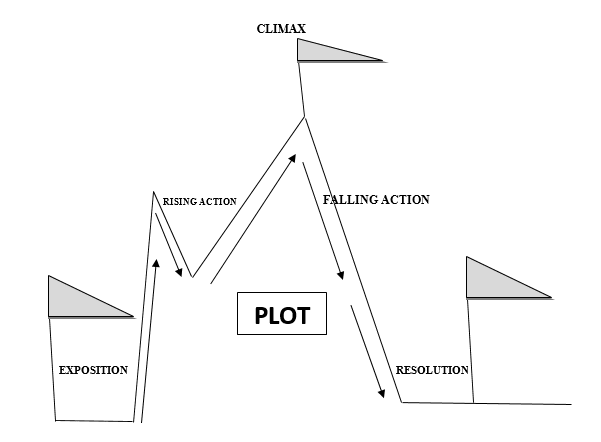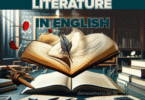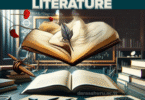ELEMENTS OF LITERATURE – FORM
Any literary work is made of two elements namely;
- Form
- Content
A) FORM
Form refers to the superstructure of a literary work. It is the principle that determines how a literary work is arranged and organized. Form consists of five elements or subparts which are;
- Plot
- Style (technique)
- Setting
- Character and characterization
- Diction (language use)
- Point of view
a) Plot
Plot is the arrangement of events in a literary work in terms of cause and effect. Is the way events and actions in a literary work has been rendered and ordered toward achieving particular artistic and emotional effects.
Types of plot
- Chronological plot: this is a straight forward plot in which events move from the beginning to the end.
- Non-chronological/flashback plot: this is a plot in which events are not sequentially arranged. Events may start at end, middle and then finish with the beginning.
Parts (elements) of plot
- Exposition: it is the foundation of the story in which settings, characters and basic situations are introduced.
- Rising action: it is the second part of the plot where suspense grows among the characters as the complications of the conflict starts.
- Climax: it is the highest point in which the conflict reaches its peak. It is the part which creates interest or suspense to the readers or audience. It is the moment of greatest danger or decision making for the protagonist. In other words, climax is the most exciting moment in the story.
- Falling action: it is a part of plot which shows what happens to the character after the climax. Normally one side among the two conflicting parts loses power and hence tensions decreases.
- Resolution (denouement): it is the final part of the story as conflicts are resolved and some mysteries are unraveled.
Freytag pyramid of plot
Parts of plot can be summarized using Freytag pyramid as follows;

b) Style (technique)
Style/technique refers to the quality that distinguishes an author’s work from the work of another author. It includes the writer’s choice and employment of figures of speech in a literary work.
In other words, technique refers to the way a literary work has been constructed and brought to the reader. In most cases, literary works are presented in;
- Dialogue or
- Monologue (soliloquy)
There are a variety of styles used by different artists in literature, but the most important technique is narrative technique.
Types of narrative techniques
Oral traditional narrative technique: it is a style which refers to the retelling of a story that resembles the traditional way of telling that have beginning styles like once upon a time…, a long time ago…, many years ago… etc.
Straight forward narrative style: it is a narration of a story that relates to what is taking place in the story from the beginning to the end of story. It is common in many novels.
Flashback: it is a narrative style in which the end or middle of the story is found at the beginning and vice versa.
Foreshadowing: it is a narrative style in which a certain character makes the predictions of the things that really happen later in the book’s event.
c) Setting
Setting refers to the time and place where and when events take place in a literary work. Basically, setting is the locale, historical time and social circumstances in which the actions of the work of art occur. Example, one can write the setting as “in Tanzania after independence”
Types of setting
Real setting: is the setting of the literary work to a real place known to It makes a literary work more realistic. Example, “The Lion and the Jewel is set in Nigeria.
Imaginary setting: it is a setting of the literary work to unreal places which are unknown to people.
Elements of setting
Geographical setting: this is the place Example, Tanzania, Nigeria, Kenya, etc.
Temporal setting: this is the time setting. It can be pre-independence, during colonialism, or after independence.
Social setting: this is a situational or environmental setting. It deals with conflicts. Example, exploitative environment, the conflict between the poor and the rich, educated and educated.
NOTE: the elements of setting can be also types of setting where geographical setting is divided into real and imaginary setting.
d) Character and characterization
Character is any participant in the action of a literary work. It can be human being or inanimate.
Types of characters
Main/major/central characters: these are characters that play an important role in a story. They are the drivers of the story in which the plot and resolution of conflicts resolve around them.
Minor characters: these are characters that do not play an important role in a story. These are characters that take small part but help the main characters to develop events.
Classification of characters
Protagonist: is the central character in a story and is often referred to as the story’s main character. He/she is faced with a conflict that must be resolved. Is a character with positive traits and the audience loved him/her.
Antagonist: is a character who opposes the He/she is the one who makes the story to move on. In other words, the antagonist is an obstacle that the protagonist must overcome at the final stage of the story.
Dynamic/developing character: is a character that changes over time, usually as a result of resolving a central conflict or major crisis.
Static character: is a character that does not change over time. His/her personality does not transform or evolve or There is not much to learn from about such character.
Round character: is a character that has complex He/she is often portrayed as a conflicted and contradictory person.
Foil character: is a character usually the antagonist that shows contrast against the He/she is usually a minor character that has traits ion aversion to the main character and frustrates the main character.
Flat character: is a character whose personalities are not complex. He/she is presented only in an outline without much individualized details.
Stock/stereotype character: is a character that occurs repeatedly in a particular literary genre, and so are recognizable as part of the form. In other words, stock character is a character borrowed from other literary works recognized by readers.
Expository character: is a character that is described or discussed either by the author or by another character.
Dramatic character: is a character in action. From his/her speech and recorded sounds, we make dedications about his or her personality, attitude and relationship with other characters.
Symbolic character: is a character whose presence in the work of art stands for an idea such as corruption, dictatorship, greed etc. in the society.
Realistic character: is a character that features true human traits. They are imaginary characters but they resemble true human beings in their Using these characters make a work of art to reflect reality.
Non-realistic character: is a character that does not feature true human
Characterization
is the process of describing a character in a work of art. It involves the process of assigning a certain duty to character in order to achieve a particular purpose by a writer or narrator.
Types of characterization
- Direct characterization: here a writer tells the character’s traits like brave, corrupt, weak etc.
- Indirect characterization: here a writer depends on the reader to draw conclusion or judgments about the character’s traits using the evidence the writer gives through different methods. (As explain in the following sub topic).
Methods of describing or identifying a character
In literary work, a character can be identified in the following ways
- Through what they think
- Through what they say
- Through what they do
- The way they behave towards others
- Through what other characters say about them
- Through what the author says about them
e) Diction (language use)
Diction refers to the choice and arrangement of words in a literary work. It is the choice and use of words for artistic effect in a literary work. It also, refers to how language has been used/employed in a work of art. In any literary work, language is commented as simple though in other way it can be complex.
f) Point of view
Refers to an angle or position from which a literary work is narrated. It is also refers to who tells the story. Therefore, it is the speaker, voice, narrator or persona of a work of art from where we get the story.
Types of point of views
First person point of view: is a type of point of view in which the narrator is one of the characters in a literary work. The pronoun “I” is employed in narrating the This narrator tells us his or her experiences. Therefore, the reader sees everything from that character’s eyes and experiences.
Second person point of view: is a type of point of view in which the pronoun “you” is employed in narrating the It is rarely used in works of literature.
Third person point of view: is the type of point of view in which the narrator is outside the This is very common point of view. The narrator uses the pronouns such as he, she or they. Thus, the narrator is not a character in the story, but an outside observer. It is grouped into two groups, namely;
Third person limited point of view: it is a point of view in which the narrator tells a story by using only one character in the whole work of
Third person omniscient point of view: it is a point of view in which the narrator reports on what several or many characters are thinking and feeling. The narrator seems to know everything about the characters of the story. This type is also known as ALL KNOWING POINT OF VIEW and the narrator is an all-knowing being.
Importance of point of view
- They are crucial foundation for any piece of
- They provide the context and back-story you need for the audience to understand the scene.
- They help the audience best see the writer’s characters and interpret the material in the way the writer intends.
- First person point of view brings inspiration for creating drama and



